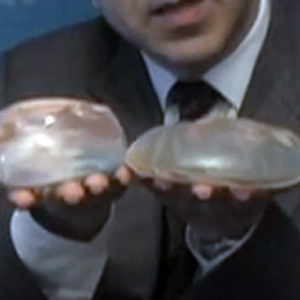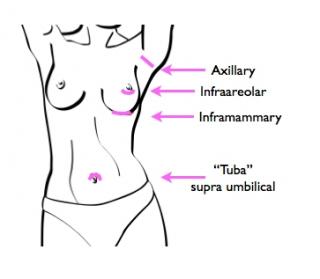
Here at CosmeticSurg, I see many women who are unhappy with the shape and/or size of their breasts. Many of my Breast augmentation patients fall into two main categories. The largest group of women I see are mothers in their thirties who have noticed a loss in skin tone, a decrease in size (most noticeable in the upper and outer portion), and a general sagging of the breasts. The other group is made up of women in their twenties who feel their breasts are too small for their body frame and want larger breasts to create an aesthetic balance.
Many of these patients, in both groups, are often surprised by the choices and considerations they’re faced with when considering a Breast augmentation.
Looking at your breasts the way a doctor does can be an emotional event full of new information which may be hard to process, but it is essential that you and your doctor are ‘on the same page’ regarding the type of implant and surgical approach that will be used. After the initial consultation, I prefer to see all of my patients one more time to be sure that we have answered all of the questions.
Here are 7 questions you should discuss and answer before having your breast augmentation procedure:
1) Saline or silicone?
There are two main types of implants, saline and silicone. Saline implants are silicone shells that are inserted empty and then filled with sterile saline after they’re placed into your breasts.
Silicone implants are inserted into the breasts in their full gel form (just as you see them in the office during your consult). More than 90% of my patients choose silicone implants since they definitely have a more natural feel. If a patient is also having a Breast lift with implants, I strongly recommend silicone implants over saline. For more information about how silicone stacks against saline, read my blog post where I discuss saline vs silicone Implants in much greater detail. Silicone implants are safe and if you have any doubt please read more about silicone implant approval history with the FDA.
2) What size implant?
This is perhaps the biggest consideration in the minds of most women. Your breast size after surgery depends on two things: how big you were before surgery and the volume of the implant inserted.
Breast implant volume is measured in CC’s (30cc = 1oz). The most popular implant size is 300cc’s. To get a general idea of you how might look with 300cc implants right from home, place 10 ounces of water in a freezer bag and place that in the lower part of your bra. During your consultation, your plastic surgeon should let you try on actual implants by placing them inside your bra. Be sure to bring two different types of tops (a blouse and a tank top) to help you make your decision about the implant size that’s right for you.
3) High profile or moderate profile?
Although implant volume is important, the shape of the implant is just as important. Most women want to be sure their breast augmentation procedures leaves them looking proportionate. A good proportion is not only determined by the breast implant size, but also by the shape of the implant as compared to the size and shape of her chest wall and torso. The choice of moderate vs. high profile has a lot to do with your anatomical chest frame dimensions. For example, if you have a really narrow chest, the round moderate profile implants may be too big of a diameter for your chest wall. Therefore, you may need to consider going with the high profile oval shape, which is not as wide of a diameter.
In comparing implants of the same size, a moderate profile breast implant has a wider, rounder base when viewed from the top. A high profile implant has a smaller, more elongated base. Therefore, when viewed from the side, the high profile implant is taller (more projection). The high profile gives more projection and more fullness near the top. The choice of implant will also affect the type of breast augmentation cleavage you get from your procedure. See moderate profile vs high profile implants to learn even more.
4) Textured or smooth implants?
Some implants have a textured surface while others have a smooth surface. A smooth implant is softer and able to move more freely than a textured implant. Really, for the past 10 years, the trend has been to go with smooth implants. I use smooth implants in most of my cases, and recommend textured only in rare instances. However, you deserve the right to know that breast implants can be smooth or textured (and to understand the benefits and risks with each) to make an informed decision.
5) Under or over the muscle?
Breast implants can be placed over the muscle or under the muscle. Below the muscle, as it is commonly referred to, is actually a partial insertion of the top part of the implant under the pectoralis major muscle. 99% of the time I recommend placing implants under the muscle because it gives the most natural look and the best long term result. The only downside is that your recovery may be a couple of days longer since the procedure is more involved to get the implant placed under the muscle.
However, keep in mind that I also recommend pain pumps for all of my breast augmentation patients. Therefore, with a pain pump, the placement of the implant under the muscle is more easily tolerated in the immediate post op recovery period. It is very rare that I ever recommend placement of implants over the muscle. If your surgeon suggests ‘over the muscle’ be sure that he has a very good reason for that choice, as inevitably the result does not hold up well over time. Knowing the location of your implants is important to understanding exactly what the plastic surgeon has planned.
6) Where to have the incision?

There are several types of breast augmentation incisions used by plastic surgeons including the inframammary incision, the infra areolar incision, the axillary incision and even the TUBA incision. There is not one best incision for all breast augmentations. Every case is individualized based on the patient’s specific choices and objectives.
Most patients with a preference have based their opinion on someone they know having had that type of incision and either liking, or not liking, the way it looks. The truth is every type of incision has its pros and cons. To learn more, read my detailed explanation of the types of Breast augmentation incisions.
7) With or without a breast lift?
If you have sagging breasts and a loss of fullness in the top portion of your breasts, you may benefit from having a breast lift in conjunction with your breast augmentation. Often, with age and particularly after pregnancy, the breast skin is stretched or the nipple begins pointing downward. For those patients, who wish to achieve the fuller appearance with better cleavage, I recommend getting breast augmentation with a breast lift.
Learn more about having a Breast lift with implants, where the combined procedures are completed during the same surgical visit. You may also want to watch the Breast lift video where I discuss how the crescent mastopexy gives me the flexibility to get the breast implant and the nipple nipple areolar complex placed exactly where I want. And, finally, to determine if you may be a candidate for a breast lift without augmentation, see After pregnancy: Breast lift or Breast augmentation?.
If you’re planning a breast augmentation procedure, consider these 7 points with great care and forethought. Every single one of my breast augmentation patients have access to various implant samples during their initial consultation and discuss these things with me to make informed decisions prior to surgery.
Implant size and profile, incision placement, and implant types are not things you want to try to guess! It’s important that you discuss them with your board certified plastic surgeon during your initial consult in order to ensure you get precisely the look your looking for.
See me explain and discuss these decisions live in this Breast augmentation video.



